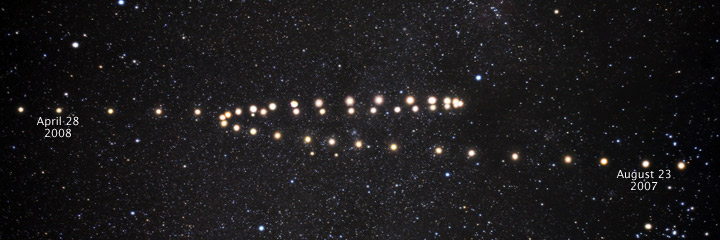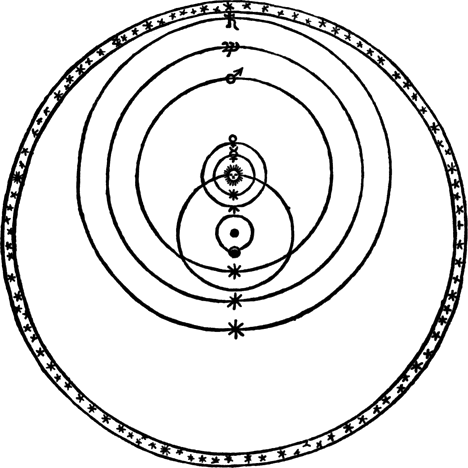

In the black dome of night, the stars seem fixed in their patterns. They rotate through the sky over the seasons so unchangingly that most cultures have used the presence of one or another constellation to tell time. The planets, however, are different, puzzling. They glide slowly and seemingly erratically across the sky. Attempts to explain why the planets move as they do led to modern science’s understanding of gravity and motion.

“We revolve around the Sun like any other planet.” —Nicolaus Copernicus
“Of all discoveries and opinions, none may have exerted a greater effect on the human spirit than the doctrine of Copernicus. The world has scarcely become known as round and complete in itself when it was asked to waive the tremendous privilege of being the center of the universe.” —Johann Wolfgang von Goethe
The ancient Greek philosophers, whose ideas shaped the worldview of Western Civilization leading up to the Scientific Revolution in the sixteenth century, had conflicting theories about why the planets moved across the sky. One camp thought that the planets orbited around the Sun, but Aristotle, whose ideas prevailed, believed that the planets and the Sun orbited Earth. He saw no sign that the Earth was in motion: no perpetual wind blew over the surface of the Earth, and a ball thrown straight up into the air doesn’t land behind the thrower, as Aristotle assumed it would if the Earth were moving. For Aristotle, this meant that the Earth had to be stationary, and the planets, the Sun, and the fixed dome of stars rotated around Earth.

For nearly 1,000 years, Aristotle’s view of a stationary Earth at the center of a revolving universe dominated natural philosophy, the name that scholars of the time used for studies of the physical world. A geocentric worldview became engrained in Christian theology, making it a doctrine of religion as much as natural philosophy. Despite that, it was a priest who brought back the idea that the Earth moves around the Sun.
In 1515, a Polish priest named Nicolaus Copernicus proposed that the Earth was a planet like Venus or Saturn, and that all planets circled the Sun. Afraid of criticism (some scholars think Copernicus was more concerned about scientific shortcomings of his theories than he was about the Church’s disapproval), he did not publish his theory until 1543, shortly before his death. The theory gathered few followers, and for a time, some of those who did give credence to the idea faced charges of heresy. Italian scientist Giordano Bruno was burned at the stake for teaching, among other heretical ideas, Copernicus’ heliocentric view of the Universe.

But the evidence for a heliocentric solar system gradually mounted. When Galileo pointed his telescope into the night sky in 1610, he saw for the first time in human history that moons orbited Jupiter. If Aristotle were right about all things orbiting Earth, then these moons could not exist. Galileo also observed the phases of Venus, which proved that the planet orbits the Sun. While Galileo did not share Bruno’s fate, he was tried for heresy under the Roman Inquisition and placed under house arrest for life.

At about the same time, German mathematician Johannes Kepler was publishing a series of laws that describe the orbits of the planets around the Sun. Still in use today, the mathematical equations provided accurate predictions of the planets’ movement under Copernican theory. In 1687, Isaac Newton put the final nail in the coffin for the Aristotelian, geocentric view of the Universe. Building on Kepler’s laws, Newton explained why the planets moved as they did around the Sun and he gave the force that kept them in check a name: gravity.
While Copernicus rightly observed that the planets revolve around the Sun, it was Kepler who correctly defined their orbits. At the age of 27, Kepler became the assistant of a wealthy astronomer, Tycho Brahe, who asked him to define the orbit of Mars. Brahe had collected a lifetime of astronomical observations, which, on his death, passed into Kepler’s hands. (Brahe, who had his own Earth-centered model of the Universe, withheld the bulk of his observations from Kepler at least in part because he did not want Kepler to use them to prove Copernican theory correct.) Using these observations, Kepler found that the orbits of the planets followed three laws.

Like many philosophers of his era, Kepler had a mystical belief that the circle was the Universe’s perfect shape, and that as a manifestation of Divine order, the planets’ orbits must be circular. For many years, he struggled to make Brahe’s observations of the motions of Mars match up with a circular orbit.
Eventually, however, Kepler noticed that an imaginary line drawn from a planet to the Sun swept out an equal area of space in equal times, regardless of where the planet was in its orbit. If you draw a triangle out from the Sun to a planet’s position at one point in time and its position at a fixed time later—say, 5 hours, or 2 days—the area of that triangle is always the same, anywhere in the orbit. For all these triangles to have the same area, the planet must move more quickly when it is near the Sun, but more slowly when it is farthest from the Sun.
This discovery (which became Kepler’s second law of orbital motion) led to the realization of what became Kepler’s first law: that the planets move in an ellipse (a squashed circle) with the Sun at one focus point, offset from the center.

Kepler’s third law shows that there is a precise mathematical relationship between a planet’s distance from the Sun and the amount of time it takes revolve around the Sun. It was this law that inspired Newton, who came up with three laws of his own to explain why the planets move as they do.
If Kepler’s laws define the motion of the planets, Newton’s laws define motion. Thinking on Kepler’s laws, Newton realized that all motion, whether it was the orbit of the Moon around the Earth or an apple falling from a tree, followed the same basic principles. “To the same natural effects,” he wrote, “we must, as far as possible, assign the same causes.” Previous Aristotelian thinking, physicist Stephen Hawking has written, assigned different causes to different types of motion. By unifying all motion, Newton shifted the scientific perspective to a search for large, unifying patterns in nature. Newton outlined his laws in Philosophiae Naturalis Principia Mathematica (“Mathematical Principles of Natural Philosophy,”) published in 1687.
Law I. Every body perseveres in its state of rest, or of uniform motion in a right line, unless it is compelled to change that state by forces impressed theron.
In essence, a moving object won’t change speed or direction, nor will a still object start moving, unless some outside force acts on it. The law is regularly summed up in one word: inertia.
Law II. The alteration of motion is ever proportional to the motive force impressed; and is made in the direction of the right line in which that force is impressed.
Newton’s second law is most recognizable in its mathematical form, the iconic equation: F=ma. The strength of the force (F) is defined by how much it changes the motion (acceleration, a) of an object with some mass (m).
Law III. To every action there is always opposed an equal reaction: or the mutual actions of two bodies upon each other are always equal, and directed to contrary parts.
As Newton himself described: “If you press a stone with your finger, the finger is also pressed by the stone.”
Within the pages of Principia, Newton also presented his law of universal gravitation as a case study of his laws of motion. All matter exerts a force, which he called gravity, that pulls all other matter towards its center. The strength of the force depends on the mass of the object: the Sun has more gravity than Earth, which in turn has more gravity than an apple. Also, the force weakens with distance. Objects far from the Sun won’t be influenced by its gravity.

Newton’s laws of motion and gravity explained Earth’s annual journey around the Sun. Earth would move straight forward through the universe, but the Sun exerts a constant pull on our planet. This force bends Earth’s path toward the Sun, pulling the planet into an elliptical (almost circular) orbit. His theories also made it possible to explain and predict the tides. The rise and fall of ocean water levels are created by the gravitational pull of the Moon as it orbits Earth.
The ideas outlined in Newton’s laws of motion and universal gravitation stood unchallenged for nearly 220 years until Albert Einstein presented his theory of special relativity in 1905. Newton’s theory depended on the assumption that mass, time, and distance are constant regardless of where you measure them.
The theory of relativity treats time, space, and mass as fluid things, defined by an observer’s frame of reference. All of us moving through the universe on the Earth are in a single frame of reference, but an astronaut in a fast-moving spaceship would be in a different reference frame.
Within a single frame of reference, the laws of classical physics, including Newton’s laws, hold true. But Newton’s laws can’t explain the differences in motion, mass, distance, and time that result when objects are observed from two very different frames of reference. To describe motion in these situations, scientists must rely on Einstein’s theory of relativity.
At slow speeds and at large scales, however, the differences in time, length, and mass predicted by relativity are small enough that they appear to be constant, and Newton’s laws still work. In general, few things are moving at speeds fast enough for us to notice relativity. For large, slow-moving satellites, Newton’s laws still define orbits. We can still use them to launch Earth-observing satellites and predict their motion. We can use them to reach the Moon, Mars, and other places beyond Earth. For this reason, many scientists see Einstein’s laws of general and special relativity not as a replacement of Newton’s laws of motion and universal gravitation, but as the full culmination of his idea.